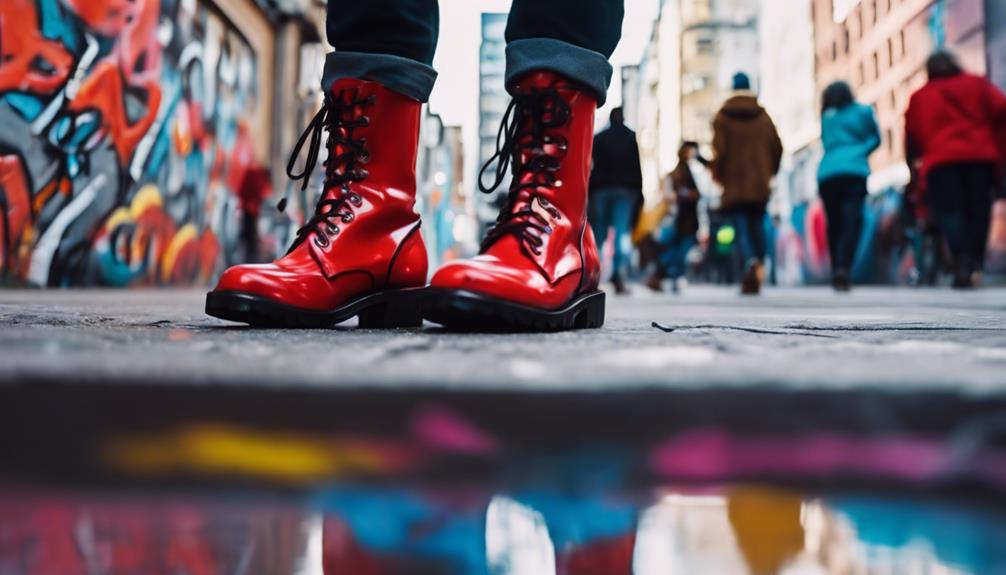The Big Red Boots, crafted by MSCHF, have emerged as a must-have fashion item, blending whimsy and nostalgia. Inspired by Astro Boy, their oversized design defies traditional footwear aesthetics and encourages self-expression. This footwear has sparked a cultural phenomenon, generating buzz about its impact on future fashion trends. While these eye-catching boots quickly sell out, enthusiasts can join email lists for restock notifications or explore alternative designs. As the brand navigates the evolving landscape of consumer desires, the frenzy surrounding these boots highlights broader trends in individuality and style. Discovering more about their cultural significance reveals deeper insights. One can also track the impact of MSCHF’s Big Red Boots by examining the resonance within the fashion community, from social media influencers to industry insiders. Additionally, blake mycoskie’s new footwear venture offers a contemporary take on personal expression through its innovative designs and unconventional approach to footwear. These boots symbolize a shift towards embracing individuality and creativity in the fashion world, setting a precedent for future trends and consumer behavior.
Key Takeaways
- The Big Red Boots, created by MSCHF, challenge traditional footwear aesthetics with their oversized and whimsical design inspired by Astro Boy.
- High demand has led to frequent sell-outs, making them a sought-after item in the fashion world and a symbol of individuality.
- The boots are made from durable plastic and rubber, evoking nostalgia and childhood cartoons, appealing to consumers' desire for unique fashion statements.
- MSCHF's innovative approach and provocative branding contribute to the cultural phenomenon surrounding the Big Red Boots, sparking discussions on future footwear design.
Overview of the Big Red Boot

The Big Red Boot, a whimsical creation from the brand MSCHF, draws inspiration from the character Astro Boy and features a striking, oversized design that challenges conventional footwear aesthetics.
Made from durable plastic and rubber, the boots exhibit a giant, clown-like appearance reminiscent of childhood cartoons, evoking comparisons to characters such as Dora the Explorer's monkey companion.
This bold aesthetic disrupts traditional notions of footwear, promoting a metaverse-like sense of freedom and creativity.
The cartoonish design encourages wearers to embrace individuality and self-expression, aligning with contemporary trends that favor playful and surreal elements in fashion.
As a result, the Big Red Boot has become a cultural phenomenon, enchanting audiences and sparking discussions about the future of footwear design.
The MSCHF Brand Journey

Founded in 2016, MSCHF has rapidly evolved from an art collective into a provocative brand known for its unconventional and boundary-pushing products. Their approach often blurs the lines between art, commerce, and culture, challenging traditional consumer expectations.
MSCHF gained notable attention with products like the Jesus Shoes, infused with holy water, and the controversial Satan Shoes, which led to legal disputes with Nike. The brand's ethos embraces absurdity and satire, attracting a dedicated following that appreciates its irreverent take on contemporary issues.
Where to Purchase Big Red Boots

Currently, the Big Red Boots are sold out, with interested buyers encouraged to join the email list for updates on future availability. This highly sought-after footwear, designed by MSCHF, has captured the attention of consumers, leading to swift sell-outs.
For those keen to secure a pair, monitoring MSCHF's official website and social media channels is advisable, as they may announce restocks or limited releases. Additionally, secondary markets may offer the boots, although prices are likely to be marked up considerably due to demand.
For an alternative option, the Astro Boots, priced at $29, are available for those who wish to embrace a similar aesthetic without the wait. MSCHF has a patent pending for the Big Red Boot, emphasizing its unique appeal.
Insights From Industry Leaders

Insights from industry leaders reveal critical strategies for steering through today's rapidly evolving business landscape.
A focus on innovation is paramount, as companies like MSCHF exemplify by merging art and commerce to create culturally resonant products like the Big Red Boot.
Leaders emphasize the importance of authentic branding and consumer engagement, which fosters loyalty and drives sales.
Additionally, adapting to emerging technologies, such as AI and social media analytics, offers businesses the tools to better understand market demands.
Collaboration across industries can also yield unique partnerships that enhance visibility and reach.
Ultimately, cultivating a culture that embraces change while prioritizing customer experiences will be essential for sustained success in this dynamic environment.
Trending Topics in Popular Culture

As cultural phenomena like the Big Red Boots capture public attention, they reflect broader trends that shape contemporary society and consumer behavior.
The rise of such unique fashion statements often signifies a collective yearning for individuality and self-expression in an increasingly homogenized world.
Social media platforms amplify these trends, as influencers and celebrities adopt eccentric styles, fostering a cycle of demand and aspirational consumption.
Furthermore, the intersection of digital culture, art, and consumerism allows brands like MSCHF to thrive by challenging conventional marketing strategies.
This emphasis on novelty and absurdity over traditional aesthetics reveals a shift towards experiential engagement, where products become symbols of identity rather than mere commodities.
Ultimately, these trends underscore a dynamic landscape of contemporary popular culture.
Frequently Asked Questions
What Sizes Are Available for the Big Red Boot?
The Big Red Boot is available in a limited range of sizes, specifically designed to accommodate various foot dimensions. For accurate sizing details, potential buyers should refer to the manufacturer's official guidelines or product specifications.
How Do I Clean and Maintain the Big Red Boot?
Imagine a beloved childhood toy—vibrant yet delicate. To clean and maintain the Big Red Boot, gently wipe with a damp cloth and mild soap, avoiding harsh chemicals to preserve its whimsical charm and integrity.
Are the Big Red Boots Suitable for All Weather Conditions?
The suitability of footwear for all weather conditions depends on materials and design. The Big Red Boots, made from plastic and rubber, offer limited insulation and breathability, making them less ideal for extreme weather conditions.
Can I Customize the Big Red Boot Design?
While the opportunity for personal expression through customization is charming, MSCHF has not officially sanctioned alterations to the Big Red Boot design, preserving its unique aesthetic and intended whimsical appeal. Enjoy its originality as is.
What Is the Return Policy for the Big Red Boot?
The return policy for the Big Red Boot allows returns within 30 days of purchase, provided the item is in its original condition. Customers should consult the official MSCHF website for detailed return instructions and eligibility criteria.
Conclusion
The Big Red Boot phenomenon underscores the evolving dynamics of contemporary consumer culture, where artistic expression and whimsical design challenge traditional fashion norms.
While some may critique the footwear's impracticality for everyday wear, this perspective overlooks the significance of these boots as a cultural statement and a form of self-expression.
The demand for such unconventional items illustrates a broader trend wherein consumers increasingly seek distinctive, statement-making pieces that reflect individuality and creativity in a saturated market.









